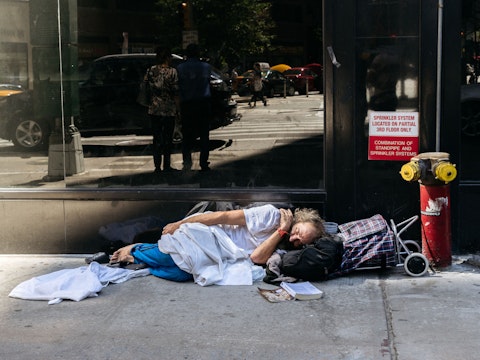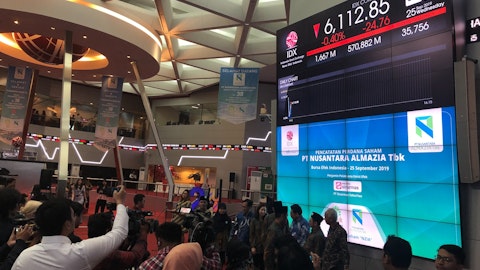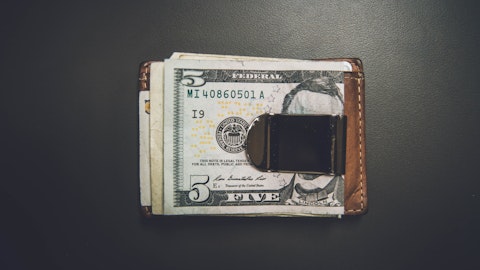In this article, we will look at the 20 least egalitarian countries in the world. We have also discussed inequalities in two highly notable countries for their social and economic issues and have analyzed how some companies are trying to help reduce them. If you want to skip our detailed analysis, head straight to the 5 Least Egalitarian Countries in the World.
While we have extensively discussed the most egalitarian countries in the world, its time to talk about the countries that are opposite. One of the least egalitarian countries, per consensus, is South Africa. Statistics show that in January 2023, South Africa witnessed 81 businesses closing their doors, down 32.5% from the 120 closures in the same month of the previous year.
However, load shedding, a severe issue in South Africa, is causing many small and medium-sized businesses to struggle. It is important to highlight that most liquidations occurred in the financing, insurance, real estate, and business services industries, with 30 closures, followed by unclassified sectors having 24 closures, and trade, catering, and accommodation companies having 13 closures. The S&P Global South Africa Purchasing Managers Index, PMI, contracted to 48.7 points in January and indicated a decline in business activity, largely attributed to the persistent energy crisis. The costs incurred by businesses due to load shedding are large, with some companies spending millions monthly on diesel generators to maintain operations.
Apart from water crises, Cape Town, South Africa, is also faced with an unprecedented water crisis due to a prolonged drought and governmental shortcomings. The city of 4 million is approaching the day when its taps could run dry. This crisis sheds light on the stark disparities in access to water resources between the wealthy and the poor. For the affluent, solutions can include drilling boreholes and wells for $6,000, purchasing machines to turn air moisture into potable water for $2,000, and even buying special washing machines that use less water for $400. Meanwhile, the less privileged are forced to rely on the government’s response and contemplate cutting back on food to afford bottled water. In Cape Town, the wealth gap is striking, with the top 10% owning over 90% of the country’s wealth, which highlights how inequality exacerbates the water crisis. Such disparities threaten the social contract as the rich secure their water supply while leaving the rest to fend for themselves.
In this situation, Procter & Gamble Co (NYSE:PG) has successfully raised 1.2 million days of clean water for needy communities in South Africa as part of its global Children’s Safe Drinking Water Programme. In collaboration with Massmart, Procter & Gamble Co (NYSE:PG) initially set a goal to raise 500,000 days of clean water to address challenges related to access to clean drinking water in the country. This goal was significantly surpassed, with 1.2 million days of clean water raised through a partnership that involved Procter & Gamble Co (NYSE:PG) donating one day’s worth of clean drinking water for every Procter & Gamble Co (NYSE:PG) product sold at Massmart stores and wholesalers. The final donation is equivalent to over 2.4 million liters of clean water, contributing to improved health, productivity, and the prevention of malnutrition.
It is worth highlighting that the Procter & Gamble Co (NYSE:PG) Children’s Safe Drinking Water Programme, active since 2004, has donated nearly 12 billion liters of clean water to needy communities worldwide, with a focus on Sub-Saharan Africa, where millions lack access to improved drinking water. This initiative relies on Procter & Gamble Co (NYSE:PG)’s Purifier of Water packets, which can treat 10 liters of heavily contaminated water, effectively killing bacteria and viruses while removing parasites and solid materials. Access to clean water not only quenches thirst but also enhances productivity, with the World Health Organization estimating that every $1 invested in clean water, sanitation, and hygiene generates $4 in increased productivity to support sustainable economic growth.
ClearBridge Sustainability Leaders Strategy made the following comment about The Procter & Gamble Company (NYSE:PG) in its Q2 2023 investor letter:
“Reinforcing defensive exposure and pushing our consumer staples positioning from underweight to overweight the benchmark, we added The Procter & Gamble Company (NYSE:PG), a leading consumer products company with leading franchises in a variety of stable categories, including fabric care, baby, beauty and health. It is a high-quality company with a track record of superior growth, market share gains, and attractive returns on capital. It also has defensive attributes when economic conditions deteriorate. Procter & Gamble is a sustainability leader with a demonstrated commitment to addressing environmental and social objectives in managing the business, and it has above-average corporate governance practices. Many Procter & Gamble products positively impact by promoting hygiene, self-care or health.”
On the other hand, Colombia, another one of the least egalitarian countries, is facing a huge challenge as it aims to transition away from fossil fuel extraction, particularly coal and oil, under the leadership of President Gustavo Petro, who advocates for a more environmentally sustainable future. Coal and oil comprise a fair portion of Colombia’s exports, with about 40-50% of its total exports coming from these sectors. The abrupt closure of coal mines in La Jagua de Ibirico resulted in huge economic consequences for the town, which also caused huge job losses and a decline in municipal income. The town’s reliance on coal is emblematic of Colombia’s broader dependence on fossil fuels, which accounts for about 9% of the central government’s income.
The transition must also ensure job opportunities for around 109,000 workers and fairly involve indigenous and black communities in renewable energy development. While some aspects of the transition, such as achieving a 100% renewable electric grid, are attainable by 2030, other critical goals, like substituting exports, economic transformation, and closure plans for mines and oil fields, still need to be realized. Speaking of jobs, check out our article about most in-demand jobs for the future.
In a promising effort towards addressing inequalities in the region, Ecopetrol SA (NYSE:EC), a Colombian-founded global energy company, is actively addressing inequalities in the region by joining the Valuable 500 initiative, which aims to engage 500 of the world’s largest companies in promoting the inclusion of people with disabilities. With 1.3 billion people globally having disabilities, Ecopetrol SA (NYSE:EC)’s Diversity and Inclusion Program incorporates six key initiatives to empower individuals with disabilities and caregivers. Notably, these initiatives reach more than 1,200 individuals, including 766 employees with disabilities and over 460 caregivers. This fosters an inclusive environment by breaking down barriers and supporting vulnerable populations, extending to more than 600 children with disabilities.
On the financial end, Ecopetrol SA (NYSE:EC), has reported a considerably large decline in its second-quarter net profit, largely attributed to weaker oil prices. The company’s net profit for the three months ending June 30 plummeted by 61% year over year, reaching 4.09 trillion pesos (approximately $1.02 billion). This decline reflects the challenging economic environment for oil companies due to concerns about a global recession, high-interest rates, banking stress in the United States, and an economic slowdown in China. In the first half of 2022, oil prices were at $105 per barrel, whereas they currently stand at $80 per barrel.
The decline in Ecopetrol SA (NYSE:EC)’s profits is consistent with similar challenges faced by regional oil peers. Mexico’s Petroleos Mexicanos (Pemex) saw its second-quarter net profits drop by almost 80%, while Brazil’s Petrobras reported a 36% decrease in net profits, though the latter managed to surpass analyst expectations. Ecopetrol SA (NYSE:EC)’s total sales declined by 21.8% during the second quarter, amounting to 34.3 trillion pesos ($7.89billion). Ecopetrol SA (NYSE:EC) is navigating a difficult path in this challenging economic context as it aims to adapt to shifting market dynamics while supporting Colombia’s transition towards a more sustainable and green energy future.

Copyright: ulubird / 123RF Stock Photo
Methodology
To compile a list of the least egalitarian countries in the world, we employed a comprehensive approach by utilizing data from both the Gini coefficient for the year 2021 and the Gender Inequality Index (GII) to determine their rankings. We considered the average rank to create this list, which we derived by averaging their respective positions on the two indexes. The Gini coefficient primarily assesses income inequality within countries, and our data source for this metric was the World Bank. As for the gender inequality index, our data was sourced from the IMF. In case of similar average rankings, the country with the lower GDP per capita has been ranked higher.
Here is a list of the least egalitarian countries in the world.
20. Paraguay
Average Rank: 44.5
Paraguay’s economy, primarily reliant on the export of natural resources, struggles with low tax collection and a high concentration of land ownership. Tax revenue accounted for less than 9.5% of GDP in 2020, with the soybean sector contributing very little in taxes. The highly mechanized agriculture industry does not require many workers, and the land remains concentrated in the hands of a few citizens.
19. Nicaragua
Average Rank: 40.5
Nicaragua has one of the highest levels of income inequality globally, with 82.3% of its population in extreme poverty, surviving on less than $1 per day. GDP per capita in the country was $2045.54 in 2021.
18. Tanzania
Average Rank: 40.5
The level of inequality is exemplified by the fact that the wealthiest 20% of Tanzania’s population is responsible for 42% of the overall consumption. Also, the poorest 20% only contribute to 7%. GDP per capita in the country was $1099.29 in 2021. It is one of the least egalitarian countries in the world.
17. Guyana
Average Rank: 33.5
Guyana faces huge income inequality due to limited access to quality education, healthcare, and job opportunities. It grapples with disparities in wealth distribution and struggles to address poverty and social inequality effectively. GDP per capita in the country was $9998.54 in 2021.
16. Uganda
Average Rank: 33.5
The Gini coefficient has remained high since 1996, exacerbated by uneven land distribution, educational disparities, and generational poverty. High government debt levels and top-down development approaches further hinder progress. GDP per capita in the country was $883.89 in 2021.
15. Haiti
Average Rank: 32
Haiti is plagued with political turmoil, exacerbated by the COVID-19 pandemic. The turmoil has led to a security crisis, rising homicides, kidnappings, and violence, threatening stability. Haiti is one of the countries with the worst inequalities.
14. Colombia
Average Rank: 31
Colombia witnessed a slight reduction in poverty in 2022; however, undernourishment, unequal housing, and income distribution persist as pressing issues. Income inequality remains stark, with the top 10% earning nearly 40% of the country’s income while the bottom 20% earning only a fraction. Rural areas experience higher poverty rates, with historically neglected regions facing greater challenges, such as high infant mortality.
13. Honduras
Average Rank: 30.5
In 2023, Honduras had a Gender Gap Index score of 0.74, indicating a gender gap of around 26%, signifying that women had roughly 26% fewer equal opportunities than men. Moreover, the gender gap in political empowerment in Honduras in that year stood at 73%. GDP per capita in the country was $2771.72 in 2021.
12. Ghana
Average Rank: 30.5
In Ghana, land ownership is considerably skewed, with approximately 8% of women compared to 30% of men owning land. According to the World Bank, gender representation in decision-making remains low as women constitute only 15% of the national parliament and only 27% of management positions in the private sector. GDP per capita in the country was $2363.3 in 2021.
11. Togo
Average Rank: 29.5
In 2018, Togo’s income share held by the lowest 20% of the population was 5.8%. This number has gradually decreased from 6.1% in 2006 to 5.8% in 2018. It is one of the least egalitarian countries in the world.
10. Lesotho
Average Rank: 29
In 2018, 16.5% of women aged 15-49 experienced physical and sexual violence from a current or former intimate partner in Lesotho. Additionally, women and girls aged 15 and above dedicated 15.6% of their time to unpaid care and household chores, while men allocated only 6.2%, per the data from the UN.
9. Papua New Guinea
Average Rank: 28.5
Papua New Guinea (PNG) exhibits severe income inequality, particularly in Asia. Additionally, a vast percentage of the country’s impoverished population, 94%, resides in rural areas, as noted by the Asian Development Bank. The need for well-maintained roads linking rural farms to domestic and international markets and expensive financing has hindered agricultural development.
8. Botswana
Average Rank: 27.5
Legal gender recognition progress in Botswana has been slow despite court rulings upholding transgender rights. Insufficient legislative and administrative measures have hindered the process, depriving transgender individuals of their rights and social inclusion. It is one of the most unequal countries in the world.
7. Guatemala
Average Rank: 24.5
Guatemala is faced with pervasive gender gaps that are inherently driven by its patriarchal structure. These inequalities affect women’s economic participation, access to education and health services, and vulnerability to violent crime. It is one of the least egalitarian countries in the world.
6. Democratic Republic of Congo
Average Rank: 23.5
In the Democratic Republic of Congo, as of February 2021, women occupied only 12.8% of parliamentary seats. Additionally, in 2018, 35.6% of women aged 15-49 reported experiencing physical and sexual violence from a current or former intimate partner in the last year. It is one of the most sexist countries in the world.
Click here to see the 5 Least Egalitarian Countries in the World.
Suggested Articles:
- 25 Highest-Paying Jobs for 18-year-olds
- 20 Highest-Paying Part-Time Jobs For College Students
- 30 High-Paying Remote Jobs Without a Degree or Experience
Disclosure: None. 20 Least Egalitarian Countries in the World was originally published on Insider Monkey.





